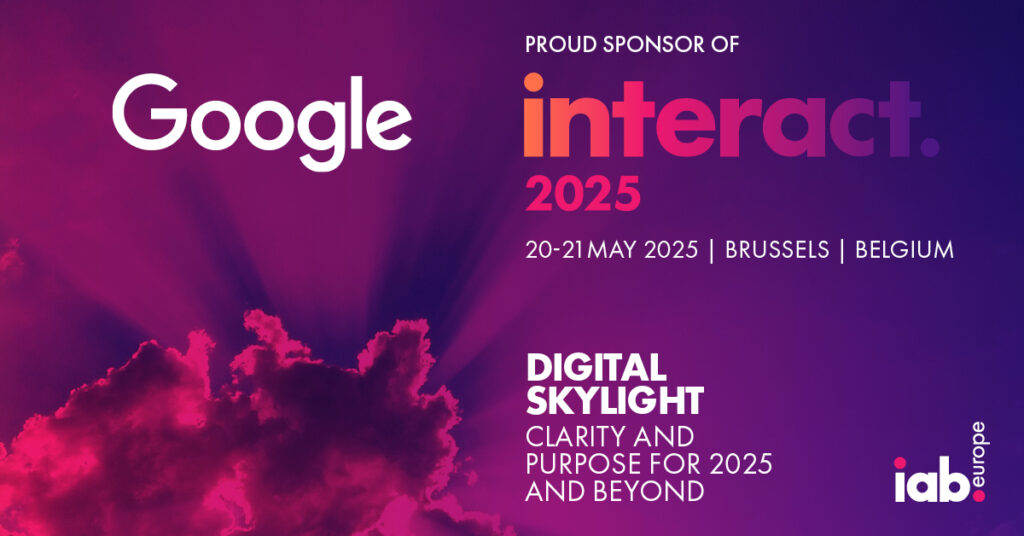Since the launch of our newly formed Advertising & Media Committee in March, we have been focused on uniting industry leaders to address the most pressing challenges and opportunities in digital advertising across Europe. Today, we are excited to introduce the new Chair and Vice Chair who will help guide the committee’s strategic direction and help shape its future impact.
We are delighted to welcome Wayne Tassie, Group Director, Netherlands at DoubleVerify, as Chair of the Advertising & Media Committee. Wayne brings a wealth of expertise in programmatic media and brand safety, as well as a strong track record of driving collaboration and innovation across the digital ecosystem.
Joining him as Vice Chair is Jörg Vogelsang, Advisor & Founder of 101con, representing BVDW. With deep experience in ad tech, programmatic strategy, and market development, Jörg brings valuable insights and a long-standing commitment to advancing transparency, efficiency, and standards in digital advertising.
Together, they will lead the committee in its mission to unite the industry to address pressing commercial and technological challenges, and guide the work of the four specialised sub-groups:
They will also drive the development and adoption of industry standards and guidelines and help foster knowledge-sharing and best practices across Europe.
Of his newly appointed position, Wayne said, “It’s an honour to have been elected Chair of IAB Europe’s Advertising & Media Committee, following my time leading the Programmatic Trading Committee. I’m excited to help shape the future of digital advertising in Europe by fostering a collaborative, inclusive environment where every committee member has a voice. Together, we have a real opportunity to drive meaningful progress, build trust, accelerate innovation, and guide the industry forward with clarity and purpose. I’d like to thank the team at IAB Europe, and Jörg Vogelsang, our Vice-Chair, for their ongoing partnership and friendship.”
Jörg also commented on his new role, saying, “I’m honoured to have been elected and grateful for the trust placed in me by the members. In times of disruption driven by AI, regulation and market shifts, we need pragmatic, scalable answers. Through our collective work within IAB Europe, we can help turn this transformation into meaningful progress – to the benefit of all participants in the digital advertising ecosystem.”
We look forward to working with Wayne and Jörg to strengthen collaboration across the ecosystem and deliver tangible value to our members.
For more information on the Advertising & Media Committee, and how to join the committee and its working groups, visit our website here or contact Marie-Clare Puffett at puffett [at] iabeurope.eu to get involved.

Wayne is a senior commercial leader, driving innovation across brands, agencies, platforms, and technology partners within the digital advertising landscape. As Group Director, Netherlands at DoubleVerify, he defines the regional vision and leads the strategy to advance media quality and accelerate performance-driven outcomes for some of the world’s most prominent local and global advertisers, fostering long-term, mutually beneficial partnerships.
Following his tenure as Chair of IAB Europe’s Programmatic Trading Committee, Wayne was elected Chair of IAB Europe’s Advertising & Media Committee, where he will elevate the work and collaboration across four critical working groups: Connected TV (CTV), Addressability & Measurement, Programmatic, and AI in Advertising.
A passionate advocate for coaching, mentorship, and industry education, Wayne has contributed to numerous external initiatives. These include podcasts, panels, and training programmes, all aimed at empowering the next generation of digital marketing professionals.

For more than 20 years, Jörg Vogelsang has held senior positions across the digital advertising and AdTech industry. As Strategic Advisor and Founder of 101con, he supports leading companies with strategy and implementation in areas such as digital advertising, adtech, and digital transformation. His career includes roles at BCN/Burda, The Trade Desk, Index Exchange, Adform, Google, and The Boston Consulting Group. Vogelsang serves as Vice Chairman of the Programmatic Advertising Focus Group at the BVDW and has been actively involved in IAB Europe initiatives for several years.

This piece was authored by DMWF. For more information, email hello@digitalmaerketingwf.com or visit the DMWF LinkedIn page here.
This June, the global marketing community will gather at Olympia, London for one of the
most anticipated events in the industry calendar - DMWF Global 2025. Returning on 24th–25th
June, the definitive event for senior leaders driving the future of marketing technology, will
bring together the brightest minds, biggest brands, and most forward-thinking professionals
from across the world to share ideas, spark innovation, and shape what’s next in digital
marketing and media.
DMWF Global has built its reputation on world-class content, strategic insight, and an
unrivalled speaker line-up. With over 2,500 senior marketing professionals, 90+ solution
providers, and 150+ influential speakers, this year’s edition is set to be the largest and
most ambitious yet.
We’re particularly excited to share that IAB Europe will be taking to the stage as part of this
year’s comprehensive agenda.
Representing a vital voice in Europe’s digital advertising ecosystem, IAB Europe has
brought together the DMWF Panel: “The Future of Streaming: Overcoming Barriers to
Growth and Investment” on the Search, Media & Advertising track. Marie-Clare Puffett,
Industry Development & Insights Director at IAB Europe will also be moderating the insightful
panel!
As consumer behaviour continues to evolve and streaming becomes an increasingly central
part of the media landscape, this discussion will explore the key challenges and
opportunities facing publishers, advertisers, and platforms. From monetisation and
measurement to investment models and user expectations, the session promises to deliver
real insight for brands navigating the next wave of content consumption.
IAB Europe’s participation highlights the event’s commitment to not only showcasing
innovation but enabling deeper, strategic dialogue between marketers, media owners, and
technology leaders.
DMWF Global 2025’s newly expanded conference agenda features 10 enhanced tracks,
each curated to reflect the industry’s most critical focus areas:
Whether you’re looking to scale your automation efforts, transform your data strategy, or
explore the impact of AI on content personalisation, each session is designed to provide
actionable strategies that drive performance and long-term value.
In an industry defined by constant evolution, DMWF Global is more than just a
conference - it’s an essential touchpoint for senior marketers seeking clarity, connection,
and competitive edge.
And this isn’t just about hearing from the big names—though they’re certainly present. With speakers from Google, Microsoft, The Coca-Cola Company, LinkedIn, TikTok Shop, Unilever, Diageo, Amazon, Mars, and many more, you’ll gain direct insight into how the world’s most recognised brands are adapting and innovating in real-time. See the full speaker line-up here.
We’re proud to partner with IAB Europe in shaping conversations that matter. As the digital advertising and marketing landscape continues to transform, it’s through events like DMWF Global that we come together to challenge thinking, share knowledge, and uncover the next wave of opportunity.
Whether you're in search, programmatic, content, data, or brand strategy—this event offers the strategic clarity and tactical inspiration needed to navigate change and lead with confidence.
Secure your place today and join us for a transformative two days of learning, insight, and real connection.
👉Register now
📄Explore the agenda
We look forward to seeing you in London this June.

From Brussels with clarity and purpose, Interact 2025 brought together the brightest minds in digital advertising for two days of inspiration, collaboration, and momentum-building. Held on 20th-21st May at the vibrant Nhow Hotel in Brussels, our flagship event gathered leaders from across Europe and beyond to tackle the big questions facing our industry today, and to find answers together.
Under the theme ‘Digital Skylight - Clarity and Purpose for 2025 and Beyond’, we explored the economic, technological, and societal shifts redefining the digital ecosystem. Through visionary keynotes, deep-dive discussions, and unmatched networking experiences, Interact 2025 set the stage for a future built on insight, innovation, and intentional growth.
Whether you joined us in person or are catching up now, this wrap-up captures the highlights, key moments, and standout sessions that defined this year’s event. Scroll down to explore event photos, video recaps, and on-stage insights in our Mainstage Morning, Interactive Workshops and Deep-Dive Masterclasses blog posts that lit the path forward for digital advertising in 2025 and beyond.
A big thank you to our sponsors, media partners, and our event host Joanna Burton for helping to make it a huge success.
Event Highlights & In-Depth Blogs:
If you’d like to know more about IAB Europe and the membership opportunities available to dive into these key topics and more, reach out to the team at communication [at] iabeurope.eu.

The energy in the room was electric as the Interact 2025 mainstage opened on 21st May 2025 in Brussels with a powerful series of keynote presentations that set the tone for the day. Bringing together influential voices from across the digital advertising ecosystem and beyond, the morning sessions delivered fresh perspectives on the economic, technological, and regulatory forces reshaping our industry.
From unpacking the latest ad spend trends and hearing brand and publisher reactions to the AdEx results, to exploring the real-world impact of AI, the next evolution of Retail Media, and what it means to build a trusted digital roadmap, the morning was packed with thought leadership that challenged, inspired, and informed.
Capping off the morning sessions, we also had a powerful and deeply moving keynote from Anastasiya Baydachenko, CEO of IAB Ukraine, who delivered a sobering and necessary perspective with "Destroying Modern War Illusions".
Check out the mainstage morning highlights below:
In this opening keynote presentation, our Chief Economist, Dr. Daniel Knapp, set the scene on European Digital Advertising investment. Daniel revealed the top-level results from our hotly anticipated AdEx Benchmark Results for 2024, which now covers 30 European markets, to show where future advertising growth will come from.
Key highlights included:
Following Daniel’s presentation, we heard an advertiser’s perspective on digital investment and innovations. In this fireside chat Alison shared her insights on what Kraft Heinz is prioritising, detailing the channels and formats that are fuelling their growth and innovation. She addressed diverse critical issues such as creativity and brand building, the evolution of media spend and Metrics, while touching upon measurement, targeting, and attribution.
Next, we heard a publisher’s perspective. In his keynote address, Bernard covered key strategy pillars, such as content, distribution, and monetisation, while outlining the fundamental elements of a successful advertising strategy for premium publishers.
After a short coffee break, we came back to the mainstage to dive into the fascinating world of AI. This session demystified the AI space by covering trends, opportunities, myths, and misconceptions, as well as getting into practicalities. Forget the fluff. Dominique talked about real examples of companies using AI in new ways, and shared a live AI multi-tooling demonstration on smarter, faster, more creative work to reveal what the future of work looks like. Attendees learned how to bring AI into an organisation and drive transformation.
Next we turned to Retail Media, where Colin draw from his direct experience working with brands and retailers around the globe such as Barilla, Fonterra, Optimum Nutrition, Superdrug, Very Group Ocado (UK), Migros (Turkey), Cencosud (Chile), Terry White Chemmart (Australia) and the Warehouse Group (New Zealand) to address the hottest topics in this space today, including creativity, effectiveness, collaboration, and performance.
The IAB Tech Lab then took us through a deep dive into the highlights of its 2025 strategy and product roadmap, with a closer look at its Trusted Server Open Source Initiative. As browsers tighten their grip on the open web, the IAB Tech Lab’s Trusted Server Framework offers publishers a path to reclaim control, shifting key ad operations server-side to restore transparency, privacy compliance, and revenue potential.
To round off the morning sessions, we had a powerful and deeply moving keynote from Anastasiya, who delivered a sobering and necessary perspective with "Destroying Modern War Illusions". Her talk reminded us of the real-world impact of war on society and business, urging the industry to stay grounded, resilient, and purposeful as we navigate both progress and crisis.

After a morning of big-picture insights on the mainstage, the afternoon workshops at Interact 2025 offered attendees the chance to roll up their sleeves and engage in hands-on, in-depth discussions on the issues shaping the next chapter of digital advertising. Designed to foster focused dialogue and actionable outcomes, each workshop brought together expert speakers, curious minds, and innovative solutions.
From evaluating the current landscape of Retail Media and unlocking the potential of Privacy Enhancing Technologies (PETs), to forecasting the future of Connected TV and dissecting what’s working and what’s not, in digital measurement, these sessions were a testament to the industry’s commitment to continuous learning and evolution.
Check out the highlights from our afternoon workshops below:
In our dedicated retail media session, we walked attendees through the forces shaping Retail Media in Europe. Growth, advancements, and opportunities were all presented for attendees to truly understand the impact of Retail Media advertising.
The session started with our Industry Development & Insights Director, Marie-Clare Puffett, providing an overview of the Retail Media ecosystem, including key stats, and developments.
We then heard from Evangelia Mitoli, Sales & New Business Development Manager at Douglas Marketing Solutions GmbH, who spoke about the role of first-party data in Retail Media and showcased how brands can benefit from DOUGLAS‘ Data Solutions along the whole customer journey.
The session concluded with an interactive panel discussion moderaated by Jason Wescott, Global Head of Commerce Solutions at GroupM and Chair of IAB Europe’s Retail & Commerce Media Committee who was joined by:
Our next workshop explored the transformative potential of Privacy-Enhancing Technologies (PETs). Through a keynote by Sebastian Grantz, Global Data & Privacy Manager, Industry Relations at Google, and an engaging panel discussion on 'Tackling PETs from different perspectives: Policy, Browser-Platforms, Industry', attendees gained insights into the latest PETs solutions and their practical applications.
Attendees left with a deeper understanding of emerging policy recommendations and the opportunities available for industry-wide collaboration on data sharing standards.
Sebastian moderated the panel discussion and was joined by:
In this session, David Cohen, CEO at IAB, led an exploration into the next generation of CTV. Attendees gained insights into the forces driving greater sophistication across buying and measurement, discovered the latest innovations propelling the channel forward, and learned how the industry is addressing measurement challenges.
The discussion also highlighted key investment trends and predictions for future growth, while offering inspiration and actionable strategies for raising the bar across the CTV ecosystem.
David moderated the session as was joined by:
In this final workshop of the day, we brought everything together to discuss advancements and focus areas in digital advertising measurement. Hosted by ExchangeWire’s CEO, Rachel Smith, a panel of measurement experts shared their views and forecasts on what we can expect from CTV, to audience measurement.
Rachel was joined by:

As the day progressed, Interact 2025 shifted into a more focused gear with a series of expert-led afternoon masterclasses designed to dive deep into the most critical and complex areas of digital advertising. These intimate, high-impact sessions offered attendees the chance to gain practical knowledge, explore emerging solutions, and walk away with actionable takeaways they could immediately apply within their organisations.
From navigating the balance between privacy and innovation, to kickstarting your AI journey, addressing audience measurement in the context of evolving EU policy, and putting the TCF into practice, these masterclasses delivered real value. Sustainability also took centre stage, with a session on how to reduce emissions across the digital supply chain and build a more sustainable future for our industry.
Our first masterclass explored the potential implications of the European Commission’s 2025 work programme for the digital advertising sector, with a focus on regulatory simplification and competitiveness. Key topics included the withdrawal of the draft ePrivacy Regulation, signalling possible changes to the EU’s privacy framework, and the upcoming review of the digital acquis. The discussion also examined the proposed European Data Union Strategy, aimed at fostering scalable data sharing while upholding robust privacy and security standards, and what all of this could mean for the future of digital advertising in Europe.
This session was moderated by Jacob Dexe, Public Affairs Manager, IAB Sweden, who ws joined by:
Dominique returned to the stage in the afternoon to help attendees cut straight to the good stuff, helping to inform and align teams on adopting AI in everyday tasks.
The session included a live demonstration on how to work smarter and more creatively with AI multi-tooling, using practical tasks from the audience, all run in AI multi-tooling format. It also offered a quick crash course on AI frameworks and best practices for research, data analytics, and content creation.
This session explored the crucial role of audience measurement within the evolving EU digital policy landscape. Key areas of focus included: the impact of the European Media Freedom Act (EMFA), the debate between independent and proprietary measurement systems, and upcoming regulatory developments. The masterclass also emphasised the increasing political significance of audience measurement for both commercial needs and public interest goals, advocating for industry collaboration and proactive engagement with regulatory oversight.
Speakers:
As the digital advertising ecosystem continues to evolve under increasing regulatory scrutiny, ensuring effective and consistent compliance with the EU Data Protection Legal Framework remains a shared challenge. This panel examined the role of the TCF Compliance Programmes in providing participants with structured ways to meet their legal requirements through audits, technical guidance, and dedicated enforcement procedures.
The session was moderated by Ninon Vagner, Privacy Director at IAB Europe who was joined by:
This masterclass provided an essential update on Ad Net Zero Europe’s progress in reducing advertising’s carbon footprint, highlighting key milestones and the importance of collaboration across markets. It unpacked the challenges and opportunities within the five Ad Net Zero actions and shared the latest on the Global Media Sustainability Framework.
IAB Europe then dived deep into the digital side of this transformation, introducing key tools that can help you start cutting emissions today. The session concluded with an interactive audience Q&A, ensuring attendees left with practical, actionable insights.
Speakers:
Brussels, Belgium, 29th May 2025 – IAB Europe has announced the official launch of its Retail Media Certification Programme for retailers, following a successful initial pilot phase. This first-of-its-kind initiative aims to set a new standard for transparency, consistency, and accountability in Retail Media measurement across Europe. Two leading retailers - Nectar360, Sainsbury’s retail media business, and Albert Heijn - are in the final stages of the compliance audit and are set to become the first certified retailers under the programme.
In parallel, IAB Europe is also launching a new beta phase of the certification programme tailored specifically for Ad Tech players that support the retail media ecosystem, expanding the programme’s impact across the broader Retail Media ecosystem.
The Retail Media Certification Programme is designed to help retailers and technology providers validate their measurement practices against industry-agreed standards. For retailers, the full certification is now available, following months of collaboration, feedback, and pilot testing during the beta phase. This rigorous process includes an independent audit to assess compliance with measurement standards in both on-site and off-site Retail Media reporting.
Commenting on the launch, Jason Wescott, Global Head of Commerce Solutions at GroupM and Chair of IAB Europe’s Retail & Commerce Media Committee, said, “A lack of standardisation has long been a barrier to retail media investment. We've addressed this by delivering both measurement standards and now a certification programme to give advertisers confidence in the networks they work with. I’m delighted Nectar360 and Albert Heijn are the first to soon be certified and look forward to welcoming ad tech participants into the next phase.”
Amir Rasekh, Managing Director, Nectar360, also said, “Our clients are at the heart of everything we do, and we’re continually working in pursuit of greater transparency, consistency, and accountability to deliver better outcomes for them. This is an important piece of work by IAB Europe, which is why we were determined to be among the first two businesses to be certified. We also understand the need to standardise and play our part in removing complexity in the retail media market for clients, whilst also continuing to innovate and develop the sophistication of our measurement practices according to their needs.”
Max de Jong, Sr. Manager Media Performance & Consumer Insights at Albert Heijn Retail Media Services, said, “We’re proud to be one of the first retailers globally to take part in this pilot. It’s another important step forward in our journey to build AH Retail Media Services into a mature, measurable, and trusted media organisation.”
The certification programme has been developed in consultation with leading industry experts, including members of IAB Europe’s Retail & Commerce Media Committee, Retailer Leaders Council, National IABs and Federations, brands, agencies, and retailers. It also aligns with global standards where possible, including ongoing coordination with the Media Rating Council (MRC) to ensure harmonisation of accreditation efforts across the Atlantic.
Independent auditors for the programme include Alliance for Audited Media (AAM), Audit Bureau of Circulations (ABC UK), and Centre d'Étude des Supports de Publicité (CESP).
Retailers interested in achieving certification can now apply here. Meanwhile, Ad Tech partners are also invited to register interest in joining the beta phase using the same form here, where they will receive guidance on the certification framework and contribute feedback to help refine the process ahead of a full rollout in 2026.
For more information about the Retail Media Certification Programme, view our FAQs here, and visit the IAB Europe website here.
To learn more and gain further insights into the Retail Media Certification Programme, join us at our upcoming Retail Media Certification Townhall on 12th June at 15:00 CET. Register here.

The digital advertising community is preparing to gather once again on the sun-soaked shores of the French Riviera for the Cannes Lions Festival 2025, taking place from 16th to 20th June. Known for its blend of creativity, insight, and inspiration (and a splash of rose and glamour), the festival remains one of the most anticipated moments in the industry calendar.
This year, IAB Europe is excited to return to Cannes to connect with leaders, spark conversations, and showcase the pivotal work we’re driving across Retail Media, Connected TV, and more.
Our Chief Economist, Daniel Knapp, Industry Development & Insights Director, Marie-Clare Puffett, Marketing & Communications Director, Lauren Wakefield, and Data Analyst & Sustianability Lead, Dimitris Beis, will be on the ground and available to share insights, discuss industry developments and opportunities, and highlight how our initiatives can support your strategic goals. If you'd like to meet with the team, get in touch!
Here’s a sneak peek at what’s in store for our time in Cannes:
Global Media Sustainability Framework v1.2 Launch
Join us at the Sustainability Hub, Palais (next to the Debussy Theatre - Palais pass required) for the release of GMSF v1.2.
This is the first major update to the framework filling major data gaps – especially in digital – and equipping advertisers, agencies, and media owners with voluntary industry standards to estimate and reduce emissions across six main media channels.
Speakers include our very own Data Analyst and Sustainability Lead, Dimitris, alongside:
Coffee & Commerce in Cannes with PubMatic
In partnership with PubMatic, we are hosting an exclusive breakfast and roundtable discussion.
Attendees will be among the first to hear key findings from IAB Europe’s Attitudes to Retail Media survey and learn how advertisers, agencies, and Retail Media Networks across Europe are approaching investment, growth, and innovation. They’ll also gain fresh insights from PubMatic on how the open internet is powering the next wave of commerce media and what it means for the future of the industry.
Addressability & Measurement Round Table & Networking Session with Verve
With thanks to event hosts Verve, we will be hosting an informal roundtable and networking event for our Addressability Working Group members. Participants can expect to join industry stakeholders to hear their perspectives on the current addressability and measurement landscape in Europe. Think lively conversation with practical insights on how the landscape will develop.
If you’re working in the addressability space and are interested in attending, please vist the event page here and RSVP here to attend.
Connected TV (CTV) Measurement Roundtable Brunch with Nielsen
In partnership with Nielsen, we will host an exclusive roundtable discussion, bringing together CTV Leaders from our CTV Working Group to delve into the pivotal area of Connected TV (CTV) measurement within the European landscape. This focused roundtable will provide a valuable forum for working group members to connect, exchange insights on the latest measurement challenges and innovations, and build meaningful relationships.
If you’re working in the CTV space and are interested in attending, please email the team below.
If you are heading to Cannes and would like to connect with the team, please reach out to:

Marie-Clare Puffett
puffett [at] iabeurope.eu

Lauren Wakefield
wakefield [at] iabeurope.eu

Daniel Knapp

Dimitris Beis
beis [at] iabeurope.eu
Brussels, Belgium, 22nd May 2025 - IAB Europe, the leading European-level industry association for the digital marketing and advertising ecosystem, is pleased to announce the appointment of a new Board of Directors. Elected during the hybrid Annual General Meeting (AGM) held in Brussels on 20th May 2025, the new Board will serve a two-year mandate and support the execution of IAB Europe’s strategic priorities.
The Board is composed of 10 National Federation Members and 10 Corporate Members, representing a cross-section of Europe’s digital advertising value chain, from leading publishers and media owners to ad tech providers and agencies. This multi-stakeholder composition ensures balanced representation across the ecosystem and reinforces IAB Europe’s role as the unified voice for digital advertising in Europe.
The new Board will oversee the implementation of IAB Europe’s 2025 work plan, which centres on four strategic pillars:
National Federation Board Members:
Corporate Member Directors:
Townsend Feehan, CEO of IAB Europe, commented: "This is a transformative period for our industry, marked by evolving regulation, rapid technological innovation, and increasing demand for sustainable practices. Our 2025 board brings together an exceptional group of leaders who are committed to collaborating across national and corporate perspectives to build a responsible, transparent, and future-ready digital advertising ecosystem. The team and I look forward to working closely with them to deliver meaningful progress for our members and the wider industry."
Double-digit growth marks another year of acceleration, with Social, Video, and Retail Media leading the way.
Brussels, Belgium, 21st May 2025 – IAB Europe, the leading European-level industry association for the digital marketing and advertising ecosystem, today released its 2024 AdEx Benchmark Report live at Interact 2025, revealing that the European digital advertising market has achieved double-digit growth, surpassing €118.9 billion in annual revenue for the first time in constant currency terms.
Now in its nineteenth year, the AdEx Benchmark Report remains the definitive source for advertising expenditure insights across Europe. This year’s edition includes data from 30 national markets - welcoming Portugal for the first time - to deliver a fully harmonised digital advertising investment total for the region. Notably, the Report also offers, for the first time, a comprehensive overview of Retail Media as a category.
Despite macroeconomic uncertainty in 2022, the European digital advertising market rebounded strongly in Q4 of 2023, continuing this trajectory into 2024. The latest data reveals double-digit growth of 16%, with total investment reaching €118.9 billion, reinforcing the continued investment by advertisers in the channels and formats shaping the innovative digital advertising ecosystem. This is also the strongest growth recorded since 2011, with the exception of 2021’s digital bonanza in the wake of the COVID-19 pandemic.
Key Growth Drivers:
Market Highlights:
A Dynamic 2024 Outlook
Commenting on the results, Daniel Knapp, Chief Economist at IAB Europe, said: "Last year, we forecast a 10% growth rate for 2024, which felt ambitious at the time. Yet, the European digital advertising market exceeded these expectations, growing by 16% in constant currency terms and crossing the €100 billion milestone to reach €118.9 billion for the first time. Even using current exchange rates, the market grew by 14.9% – a testament to digital advertising's integral role in European advertising strategies. The end of 2023 marked a clear upward trend, which continued into and through 2024. While 2024 shaped up to be another healthy year, early forecasts for 2025 suggest a renewed period of volatility and that the ‘rollercoaster’ may be restarting. Driven by macroeconomic uncertainty and geopolitical tensions, including the impact of new EU tariffs, advertisers are likely to adopt a cautious, ‘wait-and-see’ approach, prioritising measurable outcomes and performance over broad experimentation.”
The full AdEx Benchmark Report 2024 is available to download on IAB Europe’s website here and provides granular insight into digital advertising trends across 30 European markets.
Join the Conversation
To explore the findings in more detail, join IAB Europe’s virtual AdEx Benchmark Townhall on 28th May at 12:00 CET, where Daniel Knapp will dive into the trends and what the results mean for the future of digital advertising in Europe. Register here.

With Interact 2025 just around the corner, we’re continuing to highlight some of the stand-out sessions scheduled at this year’s event. This time, we’re diving into the cutting-edge world of Privacy-Enhancing Technologies (PETs), brought to you by our headline sponsor, Google.
Taking place on 20th-21st May in Brussels, Interact is the European conference bringing together leaders from across the digital advertising ecosystem under one roof. With a central theme of ‘Digital Skylight – Clarity and Purpose for 2025 and Beyond,’ this year’s event will explore the economic, social, and industry forces shaping and driving the future of our industry.
As privacy regulations tighten and user expectations evolve, PETs are poised to be a critical element in ensuring the future of digital advertising remains both innovative and privacy-respecting. At Interact, one of the standout sessions will shine a light on how PETs are paving the way for a more secure, collaborative, and transparent digital ecosystem.
Find out more about the agenda here, and discover what’s in store for this session below:
Unlocking PETs: A Key Workshop at Interact 2025

In our afternoon workshop “Unlocking Privacy Innovation: PETs Solutions and Recommendations for the Digital Ecosystem,” experts will provide a deep dive into the potential of PETs to revolutionise the way digital advertising handles data privacy. The session will feature a keynote by Sebastian Grantz, Global Data & Privacy Manager at Google, and a panel discussion tackling PETs from multiple angles - policy, platform, and industry.
Of the event, Sebastian said, "I'm thrilled to be in Brussels for IAB Europe's Interact conference, diving into the exciting world of Privacy-Enhancing Technologies and the new business opportunities they unlock!"
A 360° View: Tackling PETs from Policy, Platform, and Industry Perspectives
The workshop will explore how PETs are evolving to meet the needs of privacy-conscious users and organisations alike. Moderated by Sebastian Grantz, the panel will include:

Peter Craddock, Partner at Keller and Heckman LLP, offering legal insights on the intersection of PETs and data protection laws like GDPR.

Alex Cone, Senior Product Manager, Privacy Sandbox at Chrome, shedding light on how browsers like Chrome are shaping the future of PETs.

Sylwia Sajewska, Country Manager Germany at Decentriq, who will highlight the ways PETs enable secure data collaboration across industries.
Don’t miss out on this critical session at Interact 2025, where industry leaders will explore the transformative potential of PETs and their role in shaping the future of digital privacy.
Last Chance to Get Your Tickets for Interact 2025
Interact 2025 isn’t just about our immersive workshops and thought leadership content on stage. It’s also the place to connect, collaborate, and build the future together, and we can't wait to welcome you to Brussels.
With less than a week to go, don’t miss out on our limited time offer for 20% off: Use code iab20eu at checkout and get 20% off your ticket!

We’re just one week away from Interact 2025, happening on 20th-21st May at nHow Brussels – and this is your final chance to register with a 20% discount!
🎟️ Register now and use code iab20eu at checkout to save: Register for Interact 2025
Under the theme ‘Digital Skylight – Clarity and Purpose for 2025 and Beyond’, Interact 2025 will bring together the brightest minds in digital advertising for two days of bold ideas, actionable insights, and game-changing conversations.
From policy and privacy to retail media and innovation, our agenda is built to inspire action and equip you with the knowledge you need to navigate the year ahead.
In a fast-evolving regulatory landscape, how can we strike the balance between privacy and progress? This essential session – “Policy in the Spotlight: Balancing Privacy and Innovation in Europe’s Evolving Regulatory Landscape” – features leaders from Microsoft, NOYB, Acxiom, and more.
Join Sebastian Grantz (Google) for a keynote on the future of PETs, followed by a panel and audience Q&A exploring real-world applications and innovations in privacy-first advertising.
Retail Media is exploding across Europe. Don’t miss insights from Colin Lewis (Retail Media Works) and Heike Schneider (Douglas Marketing Solutions) as they unpack growth opportunities and practical next steps.
Be the first to hear the results of the AdEx Benchmark 2024, presented by Daniel Knapp – a deep dive into the trends and market growth shaping the digital landscape in Europe.
Hear from leaders across top brands, publishers, tech platforms, and agencies. Walk away with practical takeaways to drive your business forward.
It’s not just about great content – it’s also about the connections you’ll make. From opening night drinks to our rooftop closing party at Rooftop 58, you’ll have plenty of opportunities to network with Europen leaders.
⏳ Final seats are going fast – don’t miss your chance to be part of Europe’s premier digital advertising event.